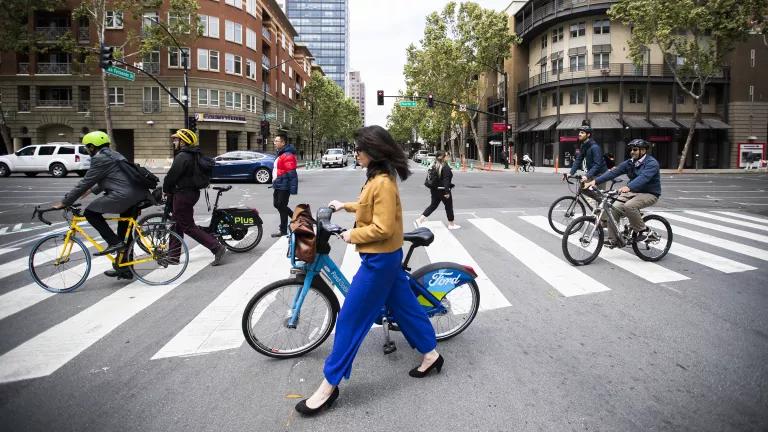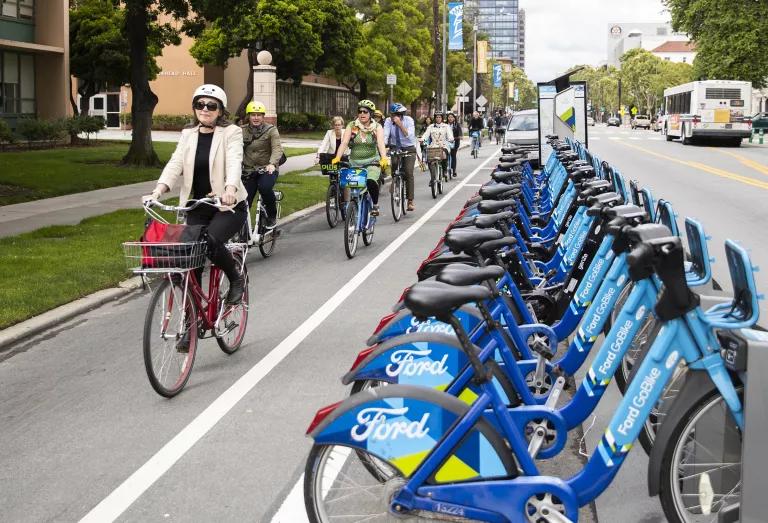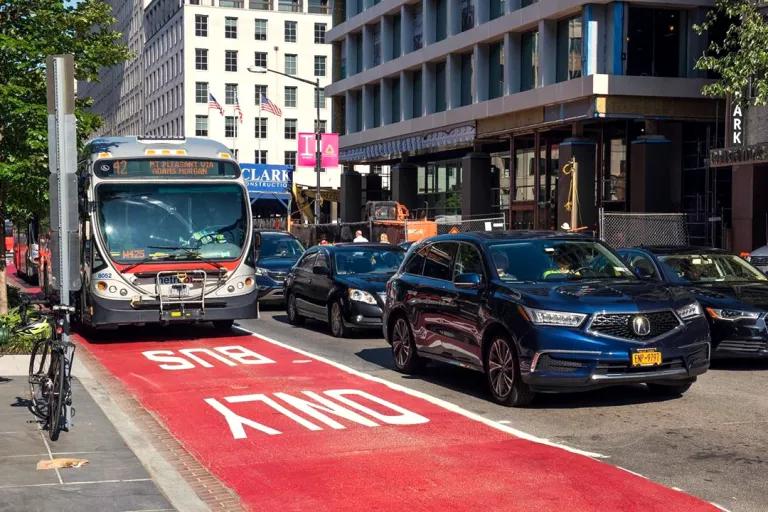What’s Good for the Climate Is Good for People in Their Everyday Lives
And right now, cities are offering up the best examples.

Cyclists and pedestrians in downtown San Jose, California
Stephen Lam for NRDC
There’s a common misconception that to reach our environmental goals, we’ll have to make certain sacrifices—do less of this, consume less of that. But right now, 25 cities across America are proving the opposite. Many of the steps they’re currently taking to curb emissions, cut pollution, and make our communities more sustainable aren’t sacrifices at all. In these cities, projects that are leading to cleaner air and smaller carbon footprints are also making daily life demonstrably better for residents. They’re not imposing burdens; they’re conferring benefits.
Twenty-five major cities are participating in the American Cities Climate Challenge, led by NRDC, Bloomberg Philanthropies, and a handful of other partners. They are stepping up to fill the void left by President Trump’s reckless decision to pull the United States out of the Paris Climate Agreement. The two-year program leverages the unique power of cities to move the needle on climate action by immediately enacting policies that promote clean energy, energy efficiency, and sustainable transportation. Fundamentally, the Climate Challenge recognizes the fact that cities are putting the most innovative and effective ideas for mitigation and adaptation into action.
Mayors and other urban leaders don’t have the option of debating, demurring, or delaying. These city leaders have to deal intimately and in real time with the impacts of climate change: every new storm surge, heat wave, and air-quality alert. Experiencing the direct impacts of the climate crisis in their own communities has stirred them to seek out and implement projects and policies that significantly reduce greenhouse gas emissions. Taken together, these efforts add up to real, measurable climate action.
But just as important, the cities taking part in the Climate Challenge are showing us how these same policies and projects can improve the daily lives of their residents right now, irrespective of future climate benefits. The transportation sector, which represents the single largest source of carbon emissions in the country, is a perfect example. There, new policies are meshing with new technologies to get people from point A to point B in ways that are not only cleaner, safer, and faster, but also easier and more enjoyable.
Protected Bike Lanes, Safer Streets for All
According to the just-published 2019 Traffic Index, cities that invest in cycling infrastructure continue to reap a host of rewards. One Climate Challenge city is leading the pack: San Jose, California, which installed 10 miles of bike paths last year and plans to install 13 more in the near future. Under its Better Bikeway initiative, streets are being reconfigured to make biking safer and more comfortable for riders of all ages and abilities—which San Jose hopes will translate into significantly increased bicycle usage, as has been the case in Denver, Seattle, and other cities.

Cyclists ride past a bike share station along San Jose's new Better Bikeways network.
It’s not just people on bikes who are benefiting. Thoughtful design elements—like parking-protected bike lanes, which create a safe channel for bikers between the sidewalk and parked vehicles—reduce car speeds and therefore make the streets safer for all, as drivers necessarily exercise greater caution in their slightly narrower lanes. Plus, more bikes (and scooters!) in the bike lane means fewer on city sidewalks. All in all, adding bike infrastructure is a public safety boon: In one recent study, researchers estimated that by installing protected bike lanes of this sort, cities could see a 44 percent drop in fatalities and a 50 percent drop in serious injuries for all road users.
The Magic Bus
Cities are increasingly recognizing the value of their bus systems. With the proper investment, local bus service can operate as swiftly and efficiently as light-rail systems. A number of Climate Challenge cities are making serious investments in their bus priority infrastructure or in full-on Bus Rapid Transit (BRT), and those cities will measure their success in terms of faster trips, increased access to job and education opportunities, and greater overall bus ridership—meaning fewer people in cars.
In traffic-clogged Washington, D.C., dedicated downtown bus lanes have just opened up along some of the city’s busiest avenues. Identified by their bright crimson color, these “red carpet” lanes are capable of carrying up to 70 buses per hour and are already receiving a warm welcome from legions of beleaguered commuters. Transit-dedicated lanes will also play a big role in Portland, Oregon, where a $36 million Central City in Motion plan aims to improve transportation options to meet the needs of the city’s growing population, and in San Antonio, whose VIA Reimagined plan is built around a new Advanced Rapid Transit system, with buses front and center.

A dedicated bus lane in Washington, DC.
Charging Ahead
While the Trump administration does everything in its power to put the brakes on electric vehicles (EVs), states and cities are busy enacting policies designed to make it much easier for people to buy—and charge—them. The Orlando Utilities Commission has begun offering financial incentives to EV purchasers and is ramping up its EV infrastructure to meet anticipated demand for more charging stations. And the city of Denver, working in harmony with Colorado’s new pro-EV governor, Jared Polis, is doing its part to encourage sales with its memorably named Pass Gas campaign, a multifaceted approach to promoting EV use among residents. A video for the campaign highlights the aspects of EVs that drivers say they love: cost savings, zippy acceleration, and the satisfaction that comes from knowing they never again have to directly support the fossil-fuel industry by visiting a gas station.
Even as the White House works to nullify climate action and Congress drags its feet, local governments—like the cities taking part in the Climate Challenge—have the energy, motivation, and policy know-how to pick up the slack. These cities’ efforts are paying off because they understand that sustainability needn’t mean sacrifice. Safeguarding the planet’s future, it turns out, can strengthen our communities, bringing real benefits to residents in the here and now.

